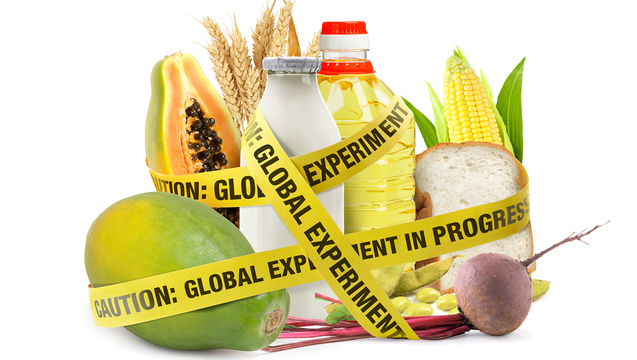
As voters in Oregon and Colorado head to the polls next week to decide if they support labeling laws for genetically modified organisms, on Tuesday we will be joined by Sheldon Krimsky to discuss his new book, The GMO Deception: What You Need to Know about the Food, Corporations, and Government Agencies Putting Our Families and Our Environment at Risk. The book has a forward by Ralph Nader and is a compilation of thought-provoking essays by leading scientists, science writers and public health advocates who, in their writing, explore the social, environmental and moral consequences of GMOs. You can read the introduction below.
Sheldon Krimsky is professor of urban and environmental policy and planning at Tufts University as well as an adjunct professor in the Department of Public Health and Family Medicine at the Tufts School of Medicine. Krimsky is also a board member of the Council for Responsible Genetics.
Excerpted with permission from The GMO Deception: What You Need to Know about the Food, Corporations, and Government Agencies Putting Our Families and Our Environment at Risk edited by Sheldon Krimsky and Jeremy Gruber. Copyright 2014, Skyhorse Publishing, Inc.
INTRODUCTION–The Science and Regulation behind the GMO Deception
Agriculture had its origins about ten thousand years ago. Throughout most of that period farmers shared seeds, selected desired phenotypes of plants, and with keen observation and experience sought to understand the environmental factors affecting crop productivity. Through selective breeding, farmers chose plants that were best adapted to their region. By saving seeds of the more desired varieties they were able to achieve shortened growing seasons, larger fruits or vegetables, enhanced disease resistance and varieties with higher nutritional value. The birth of botany as a discipline can be traced to ancient Greece. Theophrastus of Eresos (371–287 BCE), a student of Aristotle, wrote two botanical treatises summarizing the results of a millennium of experience, observation, and science from Egypt and Mesopotamia.
By the Enlightenment of the seventeenth century, experimental science had emerged. The fields of agronomy and plant breeding developed out of that milieu. In 1865 Gregor Mendel published Experiments on Plant Hybridization. Plant hybridization (or cross breeding) involves crosses between populations, breeds, or cultivars within a single species, incorporating the qualities of two different varieties into a single variety. Thus, the pollen of plants with one desired trait was transferred to a plant variety with other desired traits. This could only be achieved with plant varieties that were closely related.
Hybridization created plants more suitable for the palette of modern humans.
With the discovery in the first half of the twentieth century that radiation and chemicals could create mutations (or changes in the DNA code) in plant cells and germ plasm, plant breeders deliberately induced mutations that they hoped would produce more desirable plant varieties. This was a long, tedious, and unpredictable process. Nevertheless, it is estimated that more than 2,500 new plant varieties were produced using radiation mutagenesis.
Tissue culture engineering was another technique used in plant breeding. Once a desirable plant variety was found, the plant could be cloned by extracting a small piece of the plant tissue and inducing it to grow in cell culture with the appropriate media. Plant cloning from somatic cells was a forerunner to cloning of animals like Dolly the Sheep.
After the discovery of recombinant DNA molecule technology (aka gene transplantation) in the early 1970s, the new field of plant biotechnology was launched less than a decade later. Scientists were now capable of cutting and splicing genes and transferring them from one biological entity to another, thereby crossing broad species barriers. Plant biotechnology made its debut at an international symposium in Miami, Florida, in January 1983.2 Three independent groups of plant geneticists described experiments in which foreign genes were inserted into plants, leading to the creation of normal, fertile, transgenic plants, which means that they contained artificially inserted genes. The first plant used in these experiments was tobacco. And the vehicle for introducing the foreign genes into the plants was a bacterium called Agrobacterium tumefacients (A. tumefaciens).
The recombinant DNA debates had precipitated one of the greatest public science education periods in modern history, occurring at a time when environmental issues were of paramount social importance in the United States. The American consumer had begun to think about the quality, safety, and purity of food, and the organic food movement was underway. National environmental groups petitioned the government to remove dangerous pesticides from farming. In the 1980s when agricultural biotechnology was born, there was already a skepticism building among consumers and food activists that genetically modified organisms (or GMOs) would not contribute to these priorities.
While there have been longstanding controversies between vegetarians and omnivores or organic versus conventional farming, rarely has there been a time when food has divided society into two major warring camps. But that is the situation that people now find themselves throughout the world in response to genetically modified food. One camp proclaims that GMOs represent the future of food. They echo the words of Francis Bacon, the seventeenth-century philosopher and scientist, who more than four hundred years ago in the New Atlantis, prophesied a future of biotechnology:
And we make by art, in the same orchards and gardens, trees and flowers to come earlier or later in their seasons, and to come up and bear more speedily, than by their natural course they do. We make them also by art greater much than their nature; and their fruit greater and sweeter, and of differing tastes, smell, colour, and figure from their nature.
Bacon saw the biotic world around him as providing the feedstock, or starting materials, for recreating plant life on the planet according to human design and utility. In more contemporary terms, the plant germ plasm holds the building blocks for new food crops just as the chemical elements of the Periodic Table were the starting material for synthetic chemistry that has brought us plastics, pesticides, and nanotechnology.
The Debate
In the view of the modern agricultural Baconians, farms are like factories. Food production must be as efficient as an assembly line. This means that the producers of food must reduce the uncertainty of inputs and speed up food production to cultivate more crops per given acre, per unit of time, per unit of labor, and per unit of resource input. They proclaim the need for higher food productivity to provide for a growing population of more than seven billion people on the planet. The American Council on Science and Health, a GMO-philic organization, believes that skeptics or non-believers are irrational luddites: “It’s truly mind-boggling that this technology, which has already provided so many benefits and will continue to do so, is being demonized to such a great extent. It’s a sad commentary on how susceptible a population deficient in scientific understanding can be to fear mongering activists with a scary agenda.”
The opposing camp is comprised largely of food purists, skeptics of industrial, high chemical input farming, critics of agribusiness, and scientists who are not convinced that genetically modified food is as safe and as ecologically sustainable as its proponents claim it to be. They point out that the altruistic promises of GMO proponents have had no relationship with the actual use of genetic engineering techniques in modern agricultural production. In fact, there have been only two commonly applied major innovations in GMO agriculture: 1) crops resistant to herbicide, and 2) crops that contain their own insecticide. Both methods were designed to find synergies with their corporate sponsor’s existing pesticide, herbicide, and fertilizer businesses in order to maximize profits. For example, a farmer who buys Monsanto’s Roundup
Ready soybeans would also need to buy Monsanto’s Roundup Ready herbicide. The GMO skeptics further claim that neither method has any direct benefit to the consumer and that both are failing to achieve productivity expectations as both weeds and insects develop resistance to these toxins.
GMO skeptics harken back to the transformation of small-scale agriculture, where crop rotation, agro-ecological diversity, family farming, animal husbandry, taste, freshness, and purity were core values. Their perspective on GMOs can best be characterized by use of the acronym GAUF: Genetically Adulterated Unlabeled Food. Consumers, especially those not on the edge of poverty and famine, are asking more from their food than its price, its plentitude, its perfect geometry, its homogenous color, and its shelf life. They are demanding that their food be grown without the use of poisons, that animal protein not be harvested at the expense of the humane treatment of sentient beings, that agricultural practices not destroy the substrate of the natural ecology (the soil), and that modern agriculture not put an end to agrarian life by turning land-based food production into industrially based cell culture and hydroponics. Finally, they believe the entire agricultural system should be sustainable. In the end, they find that the GMO technology has so far only benefited a handful of corporations, that it is expensive, polluting, it may be unsafe for humans, and it is beginning to fail to meet its own instrumental objectives.
The two camps represent opposing world views about the role and structure of agriculture in modern civilization in the post industrial age. When you ask people from the pro-GMO camp what are their core values, they will likely say productivity, profit and safety. They have no intention of producing food that will make people sick as they declare, “We cannot stay in business if our product harms people.”
The GMO-skeptics have a more nuanced view of adverse consequences. Their concerns include whether GMOs will induce subtle changes in long-term health and nutritional quality, increase food allergies, incentivize non-sustainable farming practices, create dependency on chemical inputs, justify a lack of transparency in evaluating food quality and safety, or transform farming practices into a political economy resembling serfdom where the seed is intellectual property leased by the farmer. They also include advocates for a return to conventional methods of food production, which have been marginalized because they don’t offer corporations a higher profit margin. They note, for example, that conventional methods for creating drought resistance in crops actually create higher yields than GE methods.
A 2013 report in the Village Voice summed up the new political economy of GMO agriculture: “Monsanto’s thick contracts dropped like shackles on the kitchen table of every farmer who used the company’s seed, allowing Monsanto access to the farmers’ records and fields and prohibiting them from replanting leftover seed, essentially forcing farmers to buy new seed every year or face up to $3 million in damages.”
As agricultural biotechnology has developed, three methods have been widely used for the introduction of foreign genes into plants: 1) using a bacterium or virus to carry genes into a plant, 2) using electrical shock to get pure DNA into the plant cell’s nucleus, or 3) using microprojectiles coated with DNA.
According to a report by the International Service for the Acquisition of Agri-Biotech Applications (ISAAA), a trade organization of the biotech industry, by 2012 genetically modified crops were planted on nearly a quarter of the world’s farm land, on 170 million hectares, by some 17.3 million farmers in 28 countries.
Why has a new food technology that splices DNA sequences into plant germ plasm with what is widely believed to be more precision than hybridization or mutagenesis created such controversy? The answer can be found in the essays contained in this volume which cover three decades of commentary and precautions regarding GMOs. The controversy over GMOs has divided scientists and food activists, some of whom consider GMOs benign while others believe they can reduce chemical inputs into agriculture and increase yield. The public and scientific criticism and skepticism over GMOs come from many directions. But they are connected by some form of risk evaluation. The following list of questions illustrate the range of concerns:
Are GMOs a health danger to consumers?
Do GMO crops offer farmers higher productivity or pest resistance at the expense of other crop benefits such as nutrition or taste?
Do GMOs reinforce and expand monoculture and destroy biodiversity?
Do GMOs create greater control by seed manufacturers over farmers?
Do GMOs result in one seed variety for all agricultural regions?
Do GMOs contribute to a more sustainable, locally empowered, and farmer-directed agriculture?
Do GMOs result in more or less dependency on toxic chemical inputs in agricultural production?
Do GMOs play a role in reducing world hunger?
Are the scientific studies of these questions carried out by independent scientists who have no financial interests in the outcome and who publish their findings in refereed journals?
The conventional view about GMOs held by the pro-GMO camp is expressed in this statement by Ania Wieczorek and Mark Wright:
All types of agriculture modify the genes of plants so that they will have desirable traits. The difference is that traditional forms of breeding change the plants genetics indirectly by selecting plants with specific traits, while genetic engineering changes the traits by making changes to the DNA. In traditional breeding, crosses are made in a relatively uncontrolled manner. The breeder chooses the parents to cross, but at the genetic level, the results are unpredictable. DNA from the parents recombine randomly. In contrast, genetic engineering permits highly targeted transfer of genes, quick and efficient tracking of genes in the varieties, and ultimately increased efficiency in developing new crop varieties with new and desirable traits.
The deception in this statement is that it mistakenly assumes that genetic engineering of plants is a precise technology for transplanting genes. The fact is that the insertion of foreign DNA is an imprecise and uncontrolled process. One of the common mistakes made by the pro-GMO advocates is that they treat the plant genome like a Lego construction where the insertion or deletion of a gene does not affect the other genes. They argue that adding new genes just adds new properties to the organism. This understanding of genetics was long ago proven obsolete in human biology where scientists have come to understand that most characteristics are influenced by complex interactions among multiple genes and the environment acting together. Yet proponents of GMOS continue to assert their safety based on such antiquated science. In fact the plant genome and that of any other complex living thing is like an ecosystem. This means that introducing or deleting new genes can affect other genes in the plant. This is called “pleiotropy” by biologists. There is another effect called “insertional mutagenesis” in which the added foreign genes causes a mutation in the DNA sequence proximate to it. For example, small changes in the plant genome can affect the expression of genes for nutrition or mycotoxins. There is only one way to tell and that is to test the plants that have been gene adulterated.
The fact that Americans have been consuming large amounts of GMO corn and soybeans does not mean that GMO crops are highly desirable nutritionally unless we know that other changes in the crop have not taken place. One report concludes, “Using the latest molecular analytical methods, GM crops have been shown to have different composition to their non-GM counterparts … even when the two crops are grown under the same conditions, at the same time and in the same location.”9 Studies have found that GMO soy contains lower amounts of isoflavones, GMO canola contains lower amounts of vitamin E, and GMO insecticidal rice has higher levels of sucrose, mannitol, and glutamic acid than its non-GMO counterparts. These are all results consumers should know about.
A 2009 paper in the International Journal of Biological Sciences analyzed blood and system data from trials where rats were fed three varieties of commercial varieties of genetically modified maize. They reported new side effects associated with the kidney and liver, which are the body’s primary detoxification organs. The authors of this paper strongly recommend additional long-term studies of the health risks.
Government and industry risk assessments have focused mainly on the foreign DNA introduced into the plant rather than the pleotropic effects on the plant’s genome. According to the European Commission, scientists have not found a deleterious protein introduced by genetic modification into a plant. “It can be concluded that transgenic DNA does not differ intrinsically or physically from any other DNA already present in foods and that the ingestion of transgenic DNA does not imply higher risks than ingestion of any other type of DNA.”10 And the ISAAA proclaims the commercialization of GMOs, which began in 1996, “confirmed the early promise of biotech crops to deliver substantial agronomic, environmental, economic, health, and social benefits to large and small scale farmers worldwide.”11 Yet in 2013 more than two hundred scientists were signatories to an open letter titled “No Scientific Consensus on GMO Safety.”
This takes us to another deception, and that is that GMOs are highly regulated.
The US regulatory framework for GMOs was issued in 1986 under the Coordinated Framework for Regulation of Biotechnology (US OSTP, 1986). The regulatory authority for plant biotechnology was divided among three federal agencies: the US Department of Agriculture (USDA), the Environmental Protection Agency (EPA), and the Food and Drug Administration (FDA). Under the authority of the Plant Pest Act and the Plant Quarantine Act, the USDA’s role is to insure that the GMO crop is not a plant pest—that it does not harm other crops. The EPA’s authority under the Federal Insecticide, Fungicide and Rodenticide Act (FIFRA) is over those GMO crops that possess pesticidal properties called PIPs or plants with insecticidal properties.” Thus, the EPA oversees crops bioengineered with genes that code for toxins in Bacillus thuriengensis (Bt), a natural pesticide used by organic farmers. The FDA’s authority over GMO crops is to insure human and animal safety on consumption. In 1992 the FDA issued voluntary guidelines for GMO crop manufacturers and affirmed that foreign genes introduced into crops (independent of the source) do not constitute a food additive. For the purpose of regulation, GMO crops were not to be treated any differently than hybrid crop varieties. GMO crop producers were advised to consult with the FDA according to a guidance flow chart. The FDA subsequently promulgated a mandatory pre-market non-fiction that included a requirement for GMO plant manufacturers who planned to release GMO crops, non-binding recommendations for early food safety evaluations13 and they also issued a draft guidance for labeling in January 2001.14 As of November 30, 2012 the EPA had forty-one PIPs registered including varieties of Bt corn, Bt soybeans and Bt cotton.
The FDA’s approach to risk assessment of GMO crops is based on the concept of “substantial equivalence.” While the concept has never been well-defined, it is based on the idea that when a few components of the GMO crop such as certain nutrients and amino acids are similar in content to its non- GMO counterpart, the GMO crop is declared “substantially equivalent.” The vagueness of the concept and its application to risk assessment has been widely criticized.16 The late Marc Lappé wrote, “At the core of the debate between anti-biotechnology activists and its proponents is the assertion that no meaningful differences exist between conventional and genetically engineered food. Establishing the truth of this assertion was critical to deregulating various commodity crops.”17 As previously mentioned, there is growing evidence that GMO crops can have different protein composition than non-GMO varieties.
Under its nonbinding recommendations for industry of “Non-Pesticidal Proteins Produced by New Plant Varieties Intended for Food Use introduced on June 2006,” the FDA requires the manufacturer to provide the name, identity, and function of any new protein produced in a new plant variety. It also requires information as to whether the new protein has been safely consumed in foods; the sources, purpose, or intended technical effect of the introduced genetic material; the amino acid similarity of the new protein with and known allergens and toxins; and the stability and resistance to enzymatic degradation of the protein. Within 120 days after submission for a GMO crop, the FDA will alert the manufacturer whether it has been accepted or whether there are questions about the submission (see note 6). The FDA’s data requirements do not include changes to the other gene expressions in the plant, with mutational mutagenesis and pleiotropy. As of April 2013, the FDA completed ninety-five consultations including thirty for corn, fifteen for cotton, twelve for canola, twelve for soybean, and twenty-four for all other crops including alfalfa, cantaloupe, flax, papaya, plum, potato, squash, sugar beet, tomato, and wheat. These consultations have accepted the assurances from the biotechnology industry that their safety assessment is reliable. The information the FDA receives is shrouded in confidential business information and is not transparent to the independent scientific community on the methods used and the application of the “weight of evidence.”
In a report titled “Potential Health Effects of Foods Derived from Genetically Engineered Plants: What Are the Issues?” published by the Third World Network (an international NGO), two scientists proposed a de minimus list of tests that should serve as the basis for GMO crop health assessment. The report rejects the a priori claim that GMO and hybrid crops should be treated the same. The requirement cited in the report includes a full biochemical, nutrition, and toxicological comparison between the transgene product implanted in the germ plasm of the recipient plant and the original source organism of the transgene. The report also includes a molecular examination of the possible secondary DNA inserts into the plant genome; an assessment of the variation of known toxins of GMO plants grown under different agronomic conditions; and an investigation of the nutritional, immunological, hormonal properties and the allergenicity of GMO products. Some of these tests should involve laboratory animals. The authors state, “Compositional studies and animal tests are but the first in GM risk assessment. Next, long-term, preferably lifetime-long metabolism, immunological and reproduction studies with male and female laboratory and other animal species should also be conducted under controlled conditions.”
The gap between what is being proposed by independent scientists and what is actually being done in hazard assessment of GMO crops is gargantuan. Nowhere is it greater than in the United States where the food safety requirements for GMO crops are similar to the chemical food additives designated as “generally regarded as safe” (or GRAS). In both cases the evaluation of health effects largely has been left to the manufacturers.










